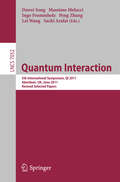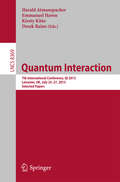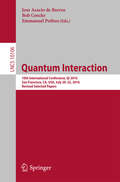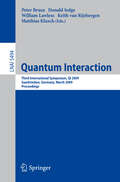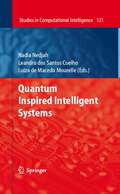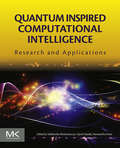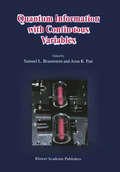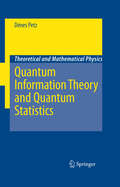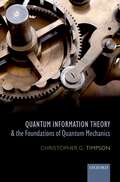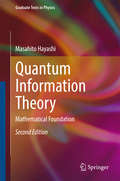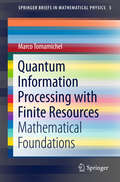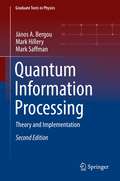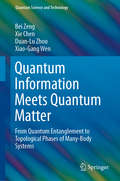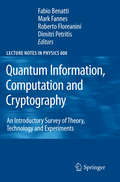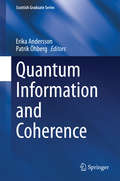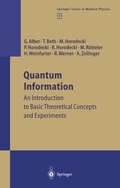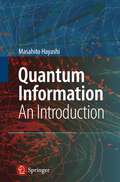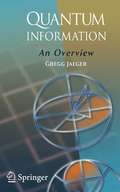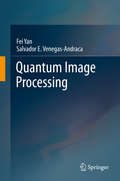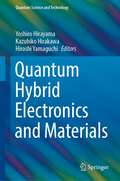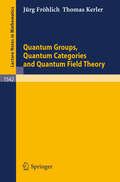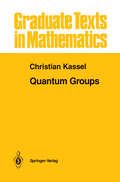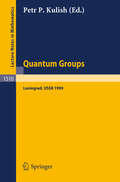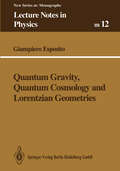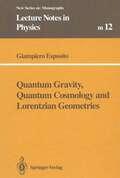- Table View
- List View
Quantum Interaction: 5th International Symposium, QI 2011, Aberdeen, UK, June 26-29, 2011, Revised Selected Papers (Lecture Notes in Computer Science #7052)
by Ingo Frommholz Peng Zhang Lei Wang Sachi Arafat Dawei Song Massimo MelucciThis book constitutes the thoroughly refereed post-conference proceedings of the 5th International Symposium on Quantum Interaction, QI 2011, held in Aberdeen, UK, in June 2011. The 26 revised full papers and 6 revised poster papers, presented together with 1 tutorial and 1 invited talk were carefully reviewed and selected from numerous submissions during two rounds of reviewing and improvement. The papers show the cross-disciplinary nature of quantum interaction covering topics such as computation, cognition, mechanics, social interaction, semantic space and information representation and retrieval.
Quantum Interaction: 7th International Conference, QI 2013, Leicester, UK, July 25-27, 2013. Selected Papers (Lecture Notes in Computer Science #8369)
by Harald Atmanspacher, Emmanuel Haven, Kirsty Kitto and Derek RaineThis book constitutes the refereed proceedings of the 7th International Conference on Quantum Interaction, QI 2013, held in Leicester, UK, in July 2013. The 31 papers presented in this book were carefully selected from numerous submissions. The papers cover various topics on quantum interaction and revolve around four themes: information processing/retrieval/semantic representation and logic; cognition and decision making; finance/economics and social structures and biological systems.
Quantum Interaction: 10th International Conference, QI 2016, San Francisco, CA, USA, July 20-22, 2016, Revised Selected Papers (Lecture Notes in Computer Science #10106)
by Jose Acacio de Barros Bob Coecke Emmanuel PothosThis book constitutes the thoroughly refereed post-conference proceedings of the 10th International Conference on Quantum Interaction, QI 2016, held in San Francisco, CA, USA, in July 2016. The 21 papers presented in this book were carefully reviewed and selected from 39 submissions. The papers address topics such as: Fundamentals; Quantum Cognition; Language and Applications; Contextuality and Foundations of Probability; and Quantum-Like Measurements.
Quantum Interaction: Third International Symposium, QI 2009, Saarbrücken, Germany, March 25-27, 2009, Proceedings (Lecture Notes in Computer Science #5494)
by C. J. Van Rijsbergen Matthias Klusch Peter Bruza Donald Sofge William LawlessThis book constitutes the refereed proceedings of the Third International Symposium on Quantum Interaction, QI 2009, held in Saarbrücken, Germany, in March 2009. The 21 revised full papers presented together with the 3 position papers were carefully reviewed and selected from numerous submissions. The papers show the cross-disciplinary nature of quantum interaction covering topics such as computation, cognition, decision theory, information retrieval, information systems, social interaction, computational linguistics and finance.
Quantum Inspired Intelligent Systems (Studies in Computational Intelligence #121)
by Leandro Dos Santos CoelhoResearch on applying principles of quantum computing to improve the engineering of intelligent systems has been launched since late 1990s. This emergent research field concentrates on studying on quantum computing that is characterized by certain principles of quantum mechanics such as standing waves, interference, quantum bits, coherence, superposition of states, and concept of interference, combined with computational intelligence or soft computing approaches, such as artificial neural networks, fuzzy systems, evolutionary computing, swarm intelligence and hybrid soft computing methods. This volume offers a wide spectrum of research work developed using soft computing combined with quantum computing systems.
Quantum Inspired Computational Intelligence: Research and Applications
by Ujjwal Maulik Siddhartha Bhattacharyya Paramartha DuttaQuantum Inspired Computational Intelligence: Research and Applications explores the latest quantum computational intelligence approaches, initiatives, and applications in computing, engineering, science, and business. The book explores this emerging field of research that applies principles of quantum mechanics to develop more efficient and robust intelligent systems. Conventional computational intelligence—or soft computing—is conjoined with quantum computing to achieve this objective. The models covered can be applied to any endeavor which handles complex and meaningful information. Brings together quantum computing with computational intelligence to achieve enhanced performance and robust solutionsIncludes numerous case studies, tools, and technologies to apply the concepts to real world practiceProvides the missing link between the research and practice
Quantum Information with Continuous Variables
by S. L. Braunstein A. K. PatiQuantum information may sound like science fiction but is, in fact, an active and extremely promising area of research, with a big dream: to build a quantum computer capable of solving problems that a classical computer could not even begin to handle. Research in quantum information science is now at an advanced enough stage for this dream to be credible and well-worth pursuing. It is, at the same time, too early to predict how quantum computers will be built, and what potential technologies will eventually strike gold in their ability to manipulate and process quantum information. One direction that has reaped many successes in quantum information processing relies on continuous variables. This area is bustling with theoretical and experimental achievements, from continuous-variable teleportation, to in-principle demonstrations of universal computation and efficient error correction. Now the time has come to compile some of the major results into one volume. In this book the leading researchers of the field present up-to-date developments of continuous-variable quantum information. This book is organized to suit many reader levels with introductions to every topic and in-depth discussions of theoretical and experimental results.
Quantum Information Theory and Quantum Statistics (Theoretical and Mathematical Physics)
by Dénes PetzThis concise and readable book addresses primarily readers with a background in classical statistical physics and introduces quantum mechanical notions as required. Conceived as a primer to bridge the gap between statistical physics and quantum information, it emphasizes concepts and thorough discussions of the fundamental notions and prepares the reader for deeper studies, not least through a selection of well chosen exercises.
Quantum Information Theory And The Foundations Of Quantum Mechanics
by Christopher G. TimpsonQuantum Information Theory and the Foundations of Quantum Mechanics is a conceptual analysis of one the most prominent and exciting new areas of physics, providing the first full-length philosophical treatment of quantum information theory and the questions it raises for our understanding of the quantum world. Beginning from a careful, revisionary, analysis of the concepts of information in the everyday and classical information-theory settings, Christopher G. Timpson argues for an ontologically deflationary account of the nature of quantum information. Against what many have supposed, quantum information can be clearly defined (it is not a primitive or vague notion) but it is not part of the material contents of the world. Timpson's account sheds light on the nature of nonlocality and information flow in the presence of entanglement and, in particular, dissolves puzzles surrounding the remarkable process of quantum teleportation. In addition it permits a clear view of what the ontological and methodological lessons provided by quantum information theory are; lessons which bear on the gripping question of what role a concept like information has to play in fundamental physics. Topics discussed include the slogan 'Information is Physical', the prospects for an informational immaterialism (the view that information rather than matter might fundamentally constitute the world), and the status of the Church-Turing hypothesis in light of quantum computation. With a clear grasp of the concept of information in hand, Timpson turns his attention to the pressing question of whether advances in quantum information theory pave the way for the resolution of the traditional conceptual problems of quantum mechanics: the deep problems which loom over measurement, nonlocality and the general nature of quantum ontology. He marks out a number of common pitfalls to be avoided before analysing in detail some concrete proposals, including the radical quantum Bayesian programme of Caves, Fuchs, and Schack. One central moral which is drawn is that, for all the interest that the quantum information-inspired approaches hold, no cheap resolutions to the traditional problems of quantum mechanics are to be had.
Quantum Information Theory: Mathematical Foundation (Graduate Texts in Physics #102)
by Masahito HayashiThis graduate textbook provides a unified view of quantum information theory. Clearly explaining the necessary mathematical basis, it merges key topics from both information-theoretic and quantum- mechanical viewpoints and provides lucid explanations of the basic results. Thanks to this unified approach, it makes accessible such advanced topics in quantum communication as quantum teleportation, superdense coding, quantum state transmission (quantum error-correction) and quantum encryption.Since the publication of the preceding book Quantum Information: An Introduction, there have been tremendous strides in the field of quantum information. In particular, the following topics – all of which are addressed here – made seen major advances: quantum state discrimination, quantum channel capacity, bipartite and multipartite entanglement, security analysis on quantum communication, reverse Shannon theorem and uncertainty relation.With regard to the analysis of quantum security, the present book employs an improved method for the evaluation of leaked information and identifies a remarkable relation between quantum security and quantum coherence. Taken together, these two improvements allow a better analysis of quantum state transmission. In addition, various types of the newly discovered uncertainty relation are explained.Presenting a wealth of new developments, the book introduces readers to the latest advances and challenges in quantum information.To aid in understanding, each chapter is accompanied by a set of exercises and solutions.
Quantum Information Processing with Finite Resources: Mathematical Foundations (SpringerBriefs in Mathematical Physics #5)
by Marco TomamichelThis book provides the reader with the mathematical framework required to fully explore the potential of small quantum information processing devices. As decoherence will continue to limit their size, it is essential to master the conceptual tools which make such investigations possible.A strong emphasis is given to information measures that are essential for the study of devices of finite size, including Rényi entropies and smooth entropies. The presentation is self-contained and includes rigorous and concise proofs of the most important properties of these measures. The first chapters will introduce the formalism of quantum mechanics, with particular emphasis on norms and metrics for quantum states. This is necessary to explore quantum generalizations of Rényi divergence and conditional entropy, information measures that lie at the core of information theory. The smooth entropy framework is discussed next and provides a natural means to lift many arguments from information theory to the quantum setting.Finally selected applications of the theory to statistics and cryptography are discussed.The book is aimed at graduate students in Physics and Information Theory. Mathematical fluency is necessary, but no prior knowledge of quantum theory is required.
Quantum Information Processing: Theory and Implementation (Graduate Texts in Physics)
by János A. Bergou Mark Hillery Mark SaffmanThis new edition of a well-received textbook provides a concise introduction to both the theoretical and experimental aspects of quantum information at the graduate level. While the previous edition focused on theory, the book now incorporates discussions of experimental platforms. Several chapters on experimental implementations of quantum information protocols have been added: implementations using neutral atoms, trapped ions, optics, and solidstate systems are each presented in its own chapter. Previous chapters on entanglement, quantum measurements, quantum dynamics, quantum cryptography, and quantum algorithms have been thoroughly updated, and new additions include chapters on the stabilizer formalism and the Gottesman-Knill theorem as well as aspects of classical and quantum information theory. To facilitate learning, each chapter starts with a clear motivation to the topic and closes with exercises and a recommended reading list. Quantum Information Processing: Theory and Implementation will be essential to graduate students studying quantum information as well as and researchers in other areas of physics who wish to gain knowledge in the field.
Quantum Information Meets Quantum Matter: From Quantum Entanglement to Topological Phases of Many-Body Systems (Quantum Science and Technology)
by Bei Zeng Xie Chen Duan-Lu Zhou Xiao-Gang WenThis book approaches condensed matter physics from the perspective of quantum information science, focusing on systems with strong interaction and unconventional order for which the usual condensed matter methods like the Landau paradigm or the free fermion framework break down. Concepts and tools in quantum information science such as entanglement, quantum circuits, and the tensor network representation prove to be highly useful in studying such systems. The goal of this book is to introduce these techniques and show how they lead to a new systematic way of characterizing and classifying quantum phases in condensed matter systems. The first part of the book introduces some basic concepts in quantum information theory which are then used to study the central topic explained in Part II: local Hamiltonians and their ground states. Part III focuses on one of the major new phenomena in strongly interacting systems, the topological order, and shows how it can essentially be defined and characterized in terms of entanglement. Part IV shows that the key entanglement structure of topological states can be captured using the tensor network representation, which provides a powerful tool in the classification of quantum phases. Finally, Part V discusses the exciting prospect at the intersection of quantum information and condensed matter physics – the unification of information and matter. Intended for graduate students and researchers in condensed matter physics, quantum information science and related fields, the book is self-contained and no prior knowledge of these topics is assumed.
Quantum Information, Computation and Cryptography: An Introductory Survey of Theory, Technology and Experiments (Lecture Notes in Physics #808)
by Fabio Benatti Mark Fannes Roberto Floreanini Dimitri PetritisThis multi-authored textbook addresses graduate students with a background in physics, mathematics or computer science. No research experience is necessary. Consequently, rather than comprehensively reviewing the vast body of knowledge and literature gathered in the past twenty years, this book concentrates on a number of carefully selected aspects of quantum information theory and technology. Given the highly interdisciplinary nature of the subject, the multi-authored approach brings together different points of view from various renowned experts, providing a coherent picture of the subject matter. The book consists of ten chapters and includes examples, problems, and exercises. The first five present the mathematical tools required for a full comprehension of various aspects of quantum mechanics, classical information, and coding theory. Chapter 6 deals with the manipulation and transmission of information in the quantum realm. Chapters 7 and 8 discuss experimental implementations of quantum information ideas using photons and atoms. Finally, chapters 9 and 10 address ground-breaking applications in cryptography and computation.
Quantum Information and Coherence (Scottish Graduate Series)
by Erika Andersson Patrik ÖhbergThis book offers an introduction to ten key topics in quantum information science and quantum coherent phenomena, aimed at graduate-student level. The chapters cover some of the most recent developments in this dynamic research field where theoretical and experimental physics, combined with computer science, provide a fascinating arena for groundbreaking new concepts in information processing.The book addresses both the theoretical and experimental aspects of the subject, and clearly demonstrates how progress in experimental techniques has stimulated a great deal of theoretical effort and vice versa. Experiments are shifting from simply preparing and measuring quantum states to controlling and manipulating them, and the book outlines how the first real applications, notably quantum key distribution for secure communication, are starting to emerge. The chapters cover quantum retrodiction, ultracold quantum gases in optical lattices, optomechanics, quantum algorithms, quantum key distribution, quantum control based on measurement, orbital angular momentum of light, entanglement theory, trapped ions and quantum metrology, and open quantum systems subject to decoherence.The contributing authors have been chosen not just on the basis of their scientific expertise, but also because of their ability to offer pedagogical and well-written contributions which will be of interest to students and established researchers.
Quantum Information: An Introduction to Basic Theoretical Concepts and Experiments (Springer Tracts in Modern Physics #173)
by Gernot Alber Thomas Beth Michal Horodecki Pawel Horodecki Ryszard Horodecki Martin Rötteler Harald Weinfurter Reinhard Werner Anton ZeilingerA self-contained introduction to the basic theoretical concepts, experimental techniques and recent advances in the fields of quantum communication, quantum information and quantum computation. The introductory and self-contained character of the contributions should make this book particularly attractive to students and active researchers in physics and computer science who want to become acquainted with the underlying basic ideas and recent advances in the rapidly evolving field of quantum information processing.
Quantum Information: An Introduction
by Masahito HayashiThis graduate-level textbook provides a unified viewpoint of quantum information theory that merges key topics from both the information-theoretic and quantum- mechanical viewpoints. The text provides a unified viewpoint of quantum information theory and lucid explanations of those basic results, so that the reader fundamentally grasps advances and challenges. This unified approach makes accessible such advanced topics in quantum communication as quantum teleportation, superdense coding, quantum state transmission (quantum error-correction), and quantum encryption.
Quantum Information: An Overview
by Gregg JaegerThis book gives an overview for practitioners and students of quantum physics and information science. It provides ready access to essential information on quantum information processing and communication, such as definitions, protocols and algorithms. Quantum information science is rarely found in clear and concise form. This book brings together this information from its various sources. It allows researchers and students in a range of areas including physics, photonics, solid-state electronics, nuclear magnetic resonance and information technology, in their applied and theoretical branches, to have this vital material directly at hand.
Quantum Image Processing
by Fei Yan Salvador E. Venegas-AndracaThis book provides a comprehensive introduction to quantum image processing, which focuses on extending conventional image processing tasks to the quantum computing frameworks. It summarizes the available quantum image representations and their operations, reviews the possible quantum image applications and their implementation, and discusses the open questions and future development trends. It offers a valuable reference resource for graduate students and researchers interested in this emerging interdisciplinary field.
Quantum Hybrid Electronics and Materials (Quantum Science and Technology)
by Hiroshi Yamaguchi Yoshiro Hirayama Kazuhiko HirakawaThis book highlights recent advances in quantum control technologies with regard to hybrid quantum systems. It addresses the following topics: phonon engineering based on phononic crystals, carbon-based nano materials like graphene and nanotubes, Terahertz light technology for single-molecule and quantum dots, nuclear-spin-based metrology for semiconductor quantum systems, quantum anomalous Hall effect in magnetic topological insulators, chiral three-dimensional photonic crystals, and bio-inspired magnonic systems. Each topic, as a component in the framework of hybrid quantum systems, is concisely presented by experts at the forefront of the field. Accordingly, the book offers a valuable asset, and will help readers find advanced technologies and materials suitable for their purposes.
Quantum Groups, Quantum Categories and Quantum Field Theory (Lecture Notes in Mathematics #1542)
by Jürg Fröhlich Thomas KerlerThis book reviews recent results on low-dimensional quantum field theories and their connection with quantum group theory and the theory of braided, balanced tensor categories. It presents detailed, mathematically precise introductions to these subjects and then continues with new results. Among the main results are a detailed analysis of the representation theory of U (sl ), for q a primitive root of unity, and a semi-simple quotient thereof, a classfication of braided tensor categories generated by an object of q-dimension less than two, and an application of these results to the theory of sectors in algebraic quantum field theory. This clarifies the notion of "quantized symmetries" in quantum fieldtheory. The reader is expected to be familiar with basic notions and resultsin algebra. The book is intended for research mathematicians, mathematical physicists and graduate students.
Quantum Groups (Graduate Texts in Mathematics #155)
by Christian KasselHere is an introduction to the theory of quantum groups with emphasis on the spectacular connections with knot theory and Drinfeld's recent fundamental contributions. It presents the quantum groups attached to SL2 as well as the basic concepts of the theory of Hopf algebras. Coverage also focuses on Hopf algebras that produce solutions of the Yang-Baxter equation and provides an account of Drinfeld's elegant treatment of the monodromy of the Knizhnik-Zamolodchikov equations.
Quantum Groups: Proceedings of Workshops held in the Euler International Mathematical Institute, Leningrad, Fall 1990 (Lecture Notes in Mathematics #1510)
by Petr P. KulishThe theory of Quantum Groups is a rapidly developing area with numerous applications in mathematics and theoretical physics, e.g. in link and knot invariants in topology, q-special functions, conformal field theory, quantum integrable models. The aim of the Euler Institute's workshops was to review and compile the progress achieved in the different subfields. Near 100 participants came from 14 countries. More than 20 contributions written up for this book contain new, unpublished material and half of them include a survey of recent results in the field (deformation theory, graded differential algebras, contraction technique, knot invariants, q-special functions). FROM THE CONTENTS: V.G. Drinfeld: On Some Unsolved Problems in Quantum Group Theory.- M. Gerstenhaber, A. Giaquinto, S.D. Schack: Quantum Symmetry.- L.I. Korogodsky,L.L. Vaksman: Quantum G-Spaces and Heisenberg Algebra.-J. Stasheff: Differential Graded Lie Algebras, Quasi-Hopf Algebras and Higher Homotopy Algebras.- A.Yu. Alekseev, L.D. Faddeev, M.A. Semenov-Tian-Shansky: Hidden Quantum Groups inside Kac-Moody Algebras.- J.-L. Gervais: Quantum Group Symmetry of 2D Gravity.- T. Kohno: Invariants of 3-Manifolds Based on Conformal Field Theory and Heegaard Splitting.- O. Viro: Moves of Triangulations of a PL-Manifold.
Quantum Gravity, Quantum Cosmology and Lorentzian Geometries (Lecture Notes in Physics Monographs #12)
by Giampiero EspositoThis book is aimed at theoretical and mathematical physicists and mathematicians interested in modern gravitational physics. I have thus tried to use language familiar to readers working on classical and quantum gravity, paying attention both to difficult calculations and to existence theorems, and discussing in detail the current literature. The first aim of the book is to describe recent work on the problern of boundary conditions in one-loop quantum cosmology. The motivation of this research was to under stand whether supersymmetric theories are one-loop finite in the presence of boundaries, with application to the boundary-value problems occurring in quantum cosmology. Indeed, higher-loop calculations in the absence of boundaries are already available in the litera ture, showing that supergravity is not finite. I believe, however, that one-loop calculations in the presence of boundaries are more fundamental, in that they provide a more direct check of the inconsistency of Supersymmetrie quantum cosmology from the perturbative point of view. It therefore appears that higher-order calculations are not strictly needed, if the one-loop test already yields negative results. Even though the question is not yet settled, this research has led to many interesting, new applications of areas of theoretical and mathematical physics such as twistor theory in flat space, self-adjointness theory, the generalized lliemann zeta-function, and the theory of boundary counterterms in super gravity.
Quantum Gravity, Quantum Cosmology and Lorentzian Geometries (Lecture Notes in Physics Monographs #12)
by Giampiero EspositoThis book is aimed at theoretical and mathematical physicists and mathematicians interested in modern gravitational physics. I have thus tried to use language familiar to readers working on classical and quantum gravity, paying attention both to difficult calculations and to existence theorems, and discussing in detail the current literature. The first aim of the book is to describe recent work on the problem of boundary conditions in one-loop quantum cosmology. The motivation of this research was to under stand whether supersymmetric theories are one-loop finite in the presence of boundaries, with application to the boundary-value problemsoccurring in quantum cosmology. Indeed, higher-loop calculations in the absence of boundaries are already available in the litera ture, showing that supergravity is not finite. I believe, however, that one-loop calculations in the presence of boundaries are more fundamental, in that they provide a more direct check of the inconsistency of supersymmetric quantum cosmology from the perturbative point of view. It therefore appears that higher-order calculations are not strictly needed, if the one-loop test already yields negative results. Even though the question is not yet settled, this research has led to many interesting, new applications of areas of theoretical and mathematical physics such as twistor theory in flat space, self-adjointness theory, the generalized Riemann zeta-function, and the theory of boundary counterterms in super gravity. I have also compared in detail my work with results by other authors, explaining, whenever possible, the origin of different results, the limits of my work and the unsolved problems.
